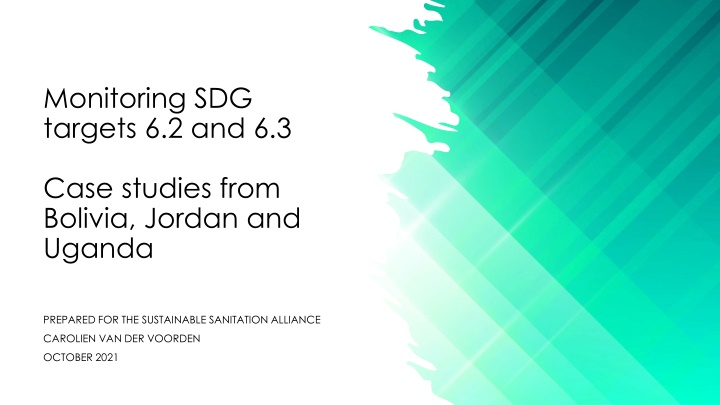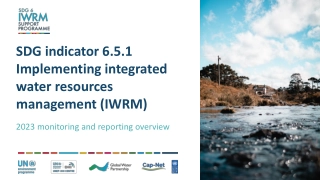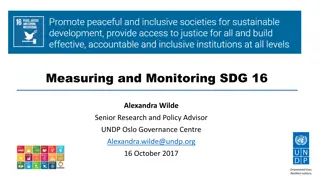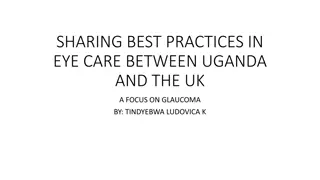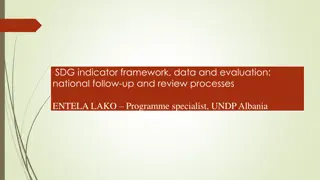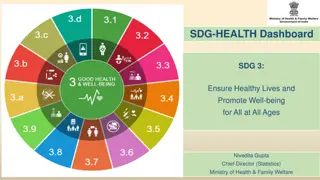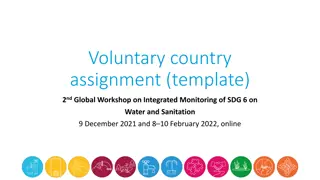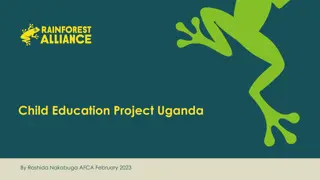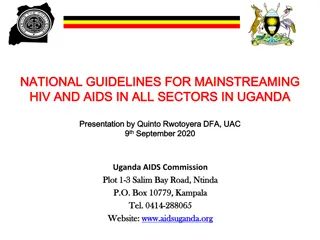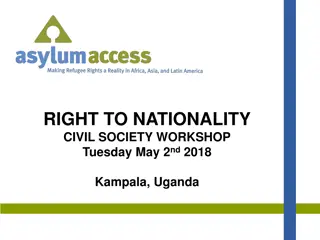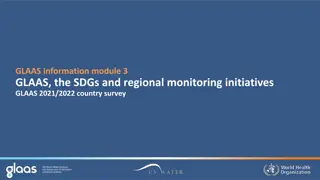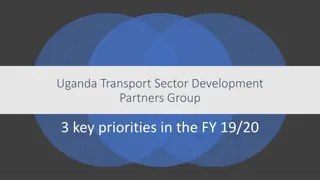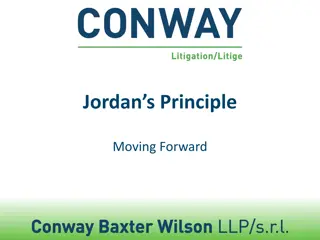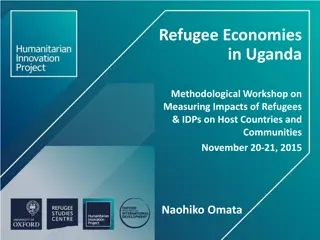Monitoring SDG Targets 6.2 and 6.3 in Bolivia, Jordan, and Uganda
Study background and country highlights of sanitation monitoring in Bolivia, Jordan, and Uganda. Explore key data on sanitation coverage and management. Discover the institutional setup, planning, and sector review for achieving Sustainable Development Goals.
Download Presentation

Please find below an Image/Link to download the presentation.
The content on the website is provided AS IS for your information and personal use only. It may not be sold, licensed, or shared on other websites without obtaining consent from the author.If you encounter any issues during the download, it is possible that the publisher has removed the file from their server.
You are allowed to download the files provided on this website for personal or commercial use, subject to the condition that they are used lawfully. All files are the property of their respective owners.
The content on the website is provided AS IS for your information and personal use only. It may not be sold, licensed, or shared on other websites without obtaining consent from the author.
E N D
Presentation Transcript
Monitoring SDG targets 6.2 and 6.3 Case studies from Bolivia, Jordan and Uganda PREPARED FOR THE SUSTAINABLE SANITATION ALLIANCE CAROLIEN VAN DER VOORDEN OCTOBER 2021
Contents Study background Country overviews Country highlights Coverage data International engagement Institutional set-up Planning and target setting Targets Sector review, coordination and participation Monitoring SDG target 6.2 and 6.3 Summary and final thoughts
Study background The Sustainable Sanitation Alliance (SuSanA) is an informal network of people and organisations who want to contribute to achieving the Sustainable Development Goals, in particular SDG 6. It provides a platform for coordination and collaborative work, connects members to a community with diverse expertise and opinions and contributes to policy dialogue. With regards to monitoring, SuSanA s Vision Document states the intention to further its work to meet the increasing need for technical assistance in developing methodologies, in designing monitoring structures compatible with existing technical and institutional capacities, and in implementing monitoring processes. As a first step to exploring deeper SuSanA engagement on SDG 6.2 and 6.3 monitoring, a rapid desk-review was commissioned to investigate the state of sanitation monitoring in three diverse countries; and to understand the institutions, actors, processes and mechanisms involved. This presentation is a summary of findings of this rapid desk review, covering Bolivia, Jordan and Uganda.
Country highlights Pluri-national state of Bolivia Hashemite Kingdom of Jordan Republic of Uganda Population: 10 million Status: upper middle-income Description: 2nd most water scarce country in the world High refugee population: 30% of total High urbanization: 91% Politically stable in a volatile region Does not explicitly recognize the Human Right to Sanitation Population: 11,5 million Population: 47 million Status: low income Status: middle-income Description: Description: Diverse geography and water resources risk of water stress Frequent water scarcity High inequality Refugee population estimated at over 1million High urbanization: 64% Politically instable Large rural population: 75% Promotor of the Human Right to Water and Sanitation Politically stable, with decentralized government Recognizes the Human right to Water and Sanitation
Safely managed sanitation and wastewater treatment Bolivia 58.29% Source: UN Water SDG6 Global Data Portal Proportion of (domestic) Wastewater safely treated Jordan 82% Source: UN Water SDG6 Global Data Portal Uganda 30% (2019/20) Source: MWE Sector Performance Report 2020
International engagement on monitoring Pluri-national state of Bolivia Hashemite Kingdom of Jordan Republic of Uganda Jordan reports to the UN- Water global analysis and assessment of sanitation and drinking-water (GLAAS) It is a member of the Sanitation and Water for All (SWA) partnership It is included in the UN- Water/WHO/UN-HABITAT pilot report on monitoring SDG 6.3 Uganda reports to the UN-Water global analysis and assessment of sanitation and drinking- water (GLAAS) It is a member of the Sanitation and Water for All (SWA) partnership It is included in the UN- Water/WHO/UN-HABITAT pilot report on monitoring SDG 6.3 Bolivia reports to the UN- Water global analysis and assessment of sanitation and drinking-water (GLAAS) It is not a member of the Sanitation and Water for All (SWA) partnership It is included in the Water and Sanitation Observatory for Latin America and the Caribbean (OLAS)
WASH Institutional set-up Pluri-national state of Bolivia Hashemite Kingdom of Jordan Republic of Uganda Lead governing body for water and sanitation: Ministry of Environment and Water (MMAyA; Ministerio de Medio Ambiente y Agua) National regulator for drinking water and basic sanitation: AAPS; key agency for sector monitoring Water and sewerage services delivered through Drinking Water and Sanitation Sewerage Service Providers (EPSA) for service areas down to 2,000 inhabitants Communities smaller than 2,000 inhabitants largely self-reliant / dependent on community- managed WASH services without external support Lead governing body for water and sanitation: Ministry of Water and Irrigation Coordinates with Water Authority of Jordan (WAJ) and the Jordan Valley Authority (JVA) Most service delivery managed by regional Water Companies, national limited liability companies owned by the Government. Ministry of Planning and International Cooperation strongly involved in monitoring, incl. through Dept. of Statistics Lead governing body for water and sanitation: Ministry of Water and Environment (MWE) National Water and Sewerage Company (NWSC) provides services in large towns, cities and some small towns; regional Umbrella Authorities serve small towns and surrounding areas Rural sanitation and hygiene promotion responsibility of Ministry of Health (rural households), Ministry of Education and Sport (schools) and MWE (small towns, public spaces and institutions)
Planning and target setting Pluri-national state of Bolivia Hashemite Kingdom of Jordan Republic of Uganda WASH targets linked to the Vision 2040 and 5-year National Development Plans (Third NDP, currently) Planning involves participation and consultation, and sector plans and budgets are approved by the Water and Environment Sector Working Group (WESWG) before parliament appropriation Specific measures to extend services to vulnerable groups exist, but no specific coverage targets WASH targets linked to Jordan 2025 A national Vision Strategy ; sector targets reflected in the National Water Strategy 2016-2025 (NWS) and the Green Growth National Action Plan Water 2021-2025 (GG-NAP) WASH targets linked to national Patriotic Agenda 2025 , sub- divided in 5-year Integral Development Sector Plans A formalized, inter-ministerial coordinating mechanism exists, but planning, target-setting and decision-making said to be highly centralized rather than consultative Limited mention of consultation and participation in planning and target setting in NWS; GG-NAP consultation included sector agencies, regional authorities, water user associations, academic institutions and the farmers union No specific measures or coverage targets in national plans to extend services to particular vulnerable groups No specific measures or coverage targets in national plans to extend services to particular vulnerable groups
Targets Pluri-national state of Bolivia Hashemite Kingdom of Jordan Republic of Uganda Targeted proportion of population connected to sewage networks: 80% by 2025 Amount of treated wastewater: 2030 target to be set after sector actions are established Additional planned actions include expansion of wastewater treatment capacity and increasing user willingness to accept wastewater reuse Aiming for elimination of open defecation and universal access to safe water and sanitation services by 2030 By 2025 aim to increase access to basic sanitation from 19 to 40%; handwashing from 34 to 50% by 2025 (Third NDP) No specific domestic wastewater treatment targets included in Third NDP Universal sanitation by 2025; 70% basic urban by 2020 (target met); 60% basic rural by 2020 (not met) No targets for eliminating open defecation 2021-2025 basic sanitation targets expected to be set around 67% nationally and 47% for rural areas On-site sanitation not counted as an improved service in urban areas Proportion of domestic wastewater treated target set at 60% for largest service providers (category A&B EPSA); 50% for smaller ones (category C&D)
Sector review, coordination and participation Pluri-national state of Bolivia Kingdom of Jordan Hashemite Republic of Uganda GLAAS: A formal government- led multi-stakeholder review mechanism is in place and applies evidence-based decision making Various donor rounds and GoJ Development Partner engagement opportunities Overall stakeholder participation and representation, including of women, remains low Better monitoring of women s involvement in WASH included as a priority action in National Water Strategy Sector-Wide Approach in place Sector coordination through WESWG, National Sanitation Working Group (NSWG) and Uganda Water and Sanitation Civil Society Network (UWASNET Annual Joint Sector Reviews since 2008; based on annual Sector Performance Reports (SPRs) Highly participatory process, including WESWG, UWASNET, Development Partners, etc. GLAAS: participation procedures defined and women s participation specified, and deemed high. Degree of coordination between government agencies and development partners evident, but no Non-Governmental stakeholders included GLAAS: Some participation procedures for service users and women defined, but medium participation in practice No evidence of regular Joint Sector Reviews
On monitoring SDG target 6.2 Pluri-national state of Bolivia Hashemite Kingdom of Jordan Republic of Uganda Regular service and performance monitoring data from Water Companies available Long term golden and platinum indicators replaced by new Sector Performance Framework aligned with SDGs in 2016/17, but roll-out to districts of the sanitation monitoring indicators and measurement framework has been slow and development of a new MIS system delayed Detailed annual performance updates published by AAPS for those EPSA regulated by the AAPS But reporting on national and SDG WASH targets less than regular current reported figures stem from 2015 (water treatment) and 2017 (population connected to sewage networks) For sanitation, AAPS performance updates only include those linked to sewers Approximately 6.8 million people are not included in regular monitoring and reporting on target 6.2, as either not linked to sewers (2.8 mln), or not serviced by EPSA (4 mln) New framework has led to higher alignment with JMP reporting in the annual SPRs, but discrepancies persist and big shifts noted e.g. rural OD jumped from 8% in 2017/18 to 22.9% in 2018/19 SDG target 6.2.1(safely managed sanitation and handwashing facility) reported as 0.84% on DOS website lack of hygiene data? Most recent alternative source of information for more comprehensive picture: 2018 National Household Survey (INE), including data on hygiene behaviours The 2020 SPR noted a persistent lack of data on a number of sector performance indicators Disaggregated data (e.g. by wealth quintile) not readily available
On monitoring SDG target 6.3 Pluri-national state of Bolivia Hashemite Kingdom of Jordan Republic of Uganda Treatment of domestic wastewater reported in AAPS Performance Updates. But more than half of EPSAs do not perform or do not report wastewater treatment. For those that do, reported proportion of treatment ranges from close to zero to more than 100. No wastewater treatment data for rural, un- connected households. Reporting on SDG targets 6.3.1 and 6.3.2 included in SPRs, albeit with No Data for 6.3.2 Proportion of wastewater safely treated reported as 30% in SPR 2020 no data for this indicator on the UN- Water SDG 6 data portal Performance-based data on treated domestic wastewater is available, albeit with gaps Performance data reported by wastewater treatment plants, illustrated by websites and annual reports But 6.3.1 reporting still based on 2015 data stated as 63.9% as opposed to the 82% reported on the UN-Water SDG 6 data portal
In summary Bolivia: A tale of two sectors: increasing data availability and quality for EPSAs, but (monitoring) rural areas largely ignored Jordan: a highly developed sector with good systems and high coverage levels, but gaps in data exist, and consultation and (civil society) participation in target setting and progress review are low Uganda: A larger, much poorer country with low sanitation coverage figures and persistent data gaps, but a strong institutional framework and a highly participatory sector, with functional and inclusive monitoring and review systems and processes
Final thoughts Strength of monitoring systems and level of participation and inclusion not necessarily linked to level of development of the country Data on SDG 6.3 more readily available in countries with higher levels of sewered sanitation UN-Water, SWA and specific development partners highly invested and active in strengthening sector monitoring Engagement of SuSanA in strengthening sanitation monitoring needs more consideration and discussion of scope
